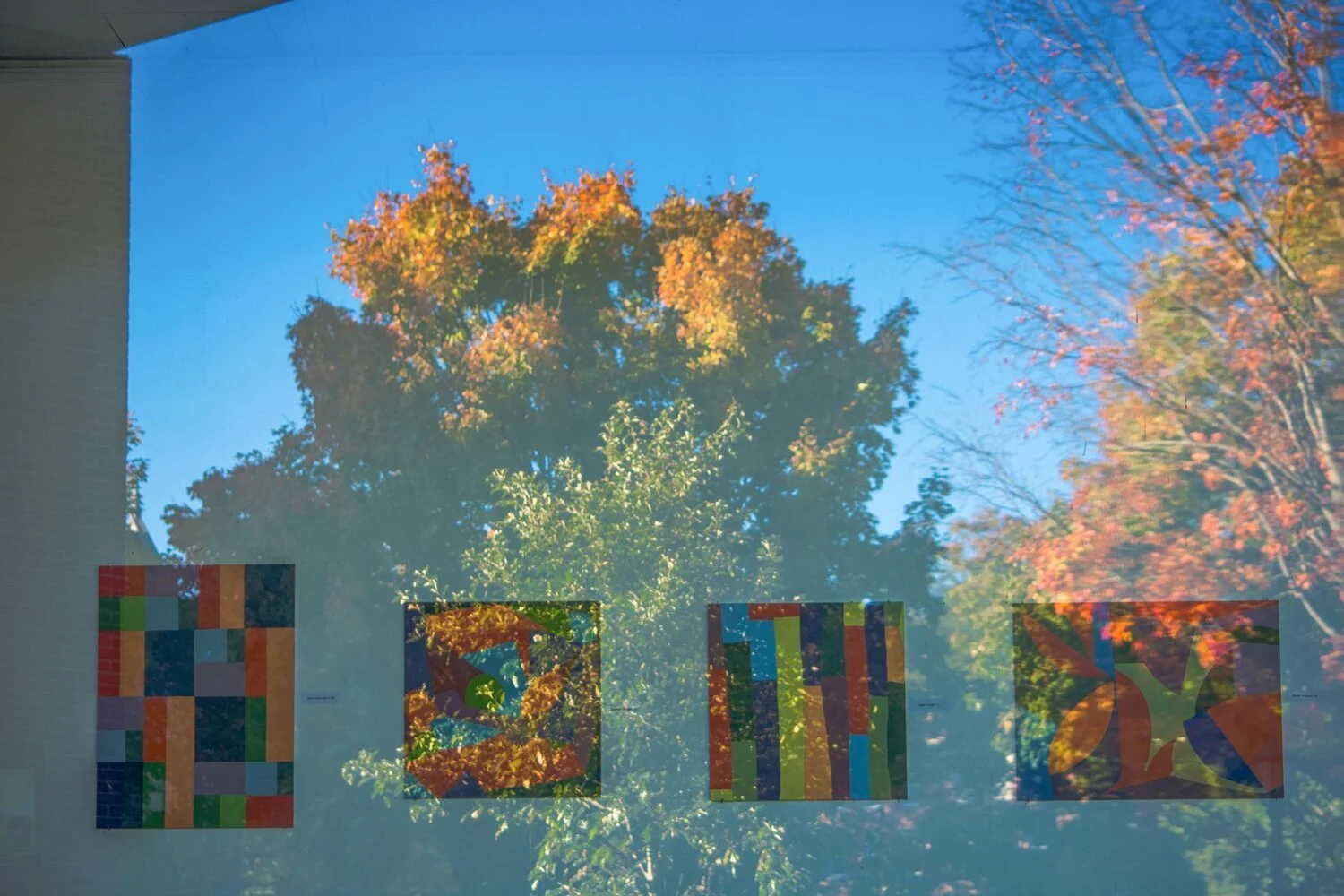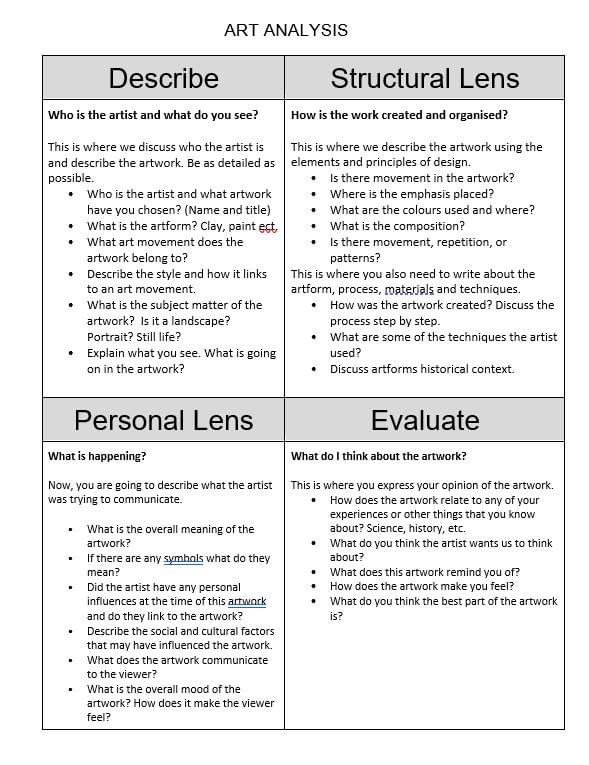
ACP Interpretive lenses
(Erika Gallery, n.d.)
The Interpretive Lenses provides students with a framework to understand the meanings and messages of artworks, and the relationships that exist between the artist, the world, the artwork and the viewer or audience. The Interpretive Lenses also assist the student to understand the communication of ideas, meanings and messages in the artwork, and the context in which the artwork is made and viewed.The Structural Lens informs the analysis and interpretation of an artwork, and its relationship with the artist and viewer or audience, through the investigation of the use of art elements and art principles, and the application of materials, techniques and processes. It also considers the stylistic qualities and symbolism evident in the artwork, and the context in which artists work and in which artworks are presented or viewed.
The Personal Lens informs the analysis and interpretation of an artwork through the investigation of the personal feelings, beliefs and life experiences of the artist, viewer or audience.
The Cultural Lens informs the analysis and interpretation of an artwork through the investigation of social, historical and cultural influences and representations.
The Structural Lens
The Structural Lens informs the analysis and interpretation of an artwork, and its relationship with the artist and viewer or audience, through the investigation of the use of art elements and art principles, and the application of materials, techniques and processes. It also considers the stylistic qualities and symbolism evident in the artwork, and the context in which artists work and in which artworks are presented or viewed. The Structural Lens can inform the other lenses.
Through Responding: Students decode artworks by reading the relationships between specific signs, symbols and conventions in visual language. They explore the stylistic qualities that are used to transmit ideas in artworks and consider the context in which artists work and in which artworks are presented and viewed.
Through Making: Students focus on the formal organisation and placement of visual components in an artwork and explore the use and communicative value of symbols, the conventions of visual language, stylistic qualities, materials, techniques and processes. They also consider the context in which their artworks are made and in which they will be presented or viewed.
The personal Lens
The Personal Lens informs the analysis and interpretation of an artwork through the investigation of the personal feelings, beliefs and life experiences of the artist. The evaluation and interpretation of an artwork can be influenced by the life experiences, personal feelings and beliefs of the viewer or audience and the context in which artists work and in which artworks are presented or viewed.
Through Responding: Students examine how artists and viewers or audiences are influenced by society, culture and personal experiences, and the context in which artists work and in which artworks are presented and viewed. They also consider how their own feelings, background, experiences, society and culture can influence their physical and emotional reactions to an artwork as a viewer or member of an audience.
Through Making: Students investigate their responses to the world around them, including their personal interests, experiences, cultural and social context and world view (beliefs and values), and the impact these have on symbolism and art practice. They consider the materials, techniques and processes used to make their artworks, as well as the context in which their artworks are made and in which they will be presented or viewed.
The cultural Lens
(Old study design, however still very applicable to the interpretive lenses)
- (VCAA, 2023)
The Cultural Lens informs the analysis and interpretation of an artwork through the investigation of social, historical and cultural influences and representations. This includes the influence of the time and place in which the artwork is made, presented or viewed, as well as the social, historical, political, philosophical and economic influences on the practices of the artist, and how these are reflected in the artwork. Other considerations include the purpose of the artwork, and the ethnicity, gender, ethics and spiritual or secular beliefs of the artist and the viewer or audience, and how these factors influence the artwork itself and the interpretation of it.
Through Responding: Students consider the regional, national, international, social and cultural identity of artists and viewers or audiences, including Aboriginal and Torres Strait Islander peoples and artists. They consider the context in which artists work and in which artworks are presented and viewed, as well as the ways artists use their artworks as a vehicle to invite change and provoke conversation.
Through Making: Students explore cultural values, historical or contemporary events, social issues, attitudes and beliefs that impact on them and others, and determine the origins of social and cultural meanings communicated in artworks. They also consider the context in which their artworks are made and in which they will be presented or viewed. In creating their own artworks, students should be aware of the cultural protocols associated with making artworks based on the practices of artists from other cultures.
Interpretive Lenses Snapshot
(Caudullo and Kelly, 2020)
Art Analysis support - Structural and Personal
Structural Lens:
Visual analysis – Use of Elements and Principles?
Materials and Techniques
Artist/Artwork Distinctive style – what’s involved and considered? - Art movement, brush strokes, colour, subject matter, etc.
Symbols and Metaphors - Are there symbols/comparisons made that represent deeper meanings?
Meanings and Messages - what’s the meaning of the artwork?
(Caudullo and Kelly, 2020)
Students consider the following questions when applying the Structural Lens:
How has the artist applied the art elements of colour, line, shape, form, texture, tone, light, sound and time, and the art principles of emphasis (focal point), movement, rhythm, unity, variety, repetition (including pattern), balance, contrast, proportion, space and scale? What effect has the use of art elements and principles had on the artwork?
How do the art elements and art principles contribute to the meanings and messages of the artwork for different audiences in different contexts?
What materials, techniques and processes have been used? How is the interpretation of the artwork shaped by the materials and the techniques or processes used by the artist? Is the interpretation informed by the inherent qualities of the materials or by their selection and application by the artist?
Are 21st-century media and technologies or approaches to making and presenting works of art evident in the artwork? How is the interpretation of the artwork shaped by the artist’s use of these?
What is the distinctive style of the artwork and how does it contribute to the meaning of the artwork? How does the artwork relate to other artworks in a similar style or from the same philosophical, ideological, social, historical or cultural context?
What physical aspects of the artwork, such as the context of where the artwork is presented, its presentation with other artworks and characteristics such as framing, display on plinths or printing of artworks, contain or suggest symbolic meaning?
How might the artwork be interpreted in different contexts by different audiences?
Does the placement or location of the artwork in a setting other than the intended setting impact on its aesthetic, cultural or economic value? Does the placement or location of the artwork impact on the communication of meaning? How does the context of where the artwork is presented communicate the beliefs of the artist, audience, culture, time or place in which was made and viewed?
- (VCAA, 2024)
Personal Lens:
Artists life and experiences
Artist personal views, expressions of opinion , philosophies
Art ideas of personal importance
Viewers life and experiences
Symbols and Metaphors
Interpretive lens introduction PPT’s
Smith, 2014, as cited in Caudullo and Kelly, 2020)
(Virtual School Victoria, n.d.)
(Caudullo and Kelly, 2020)
(Joy, as cited in Caudullo and Kelly, 2020)
(Caudullo and Kelly, 2020)
Students consider the following questions when applying the Personal Lens:
What relationship does the artwork have to the artist’s life and experiences? What visual evidence in the artwork supports this reading?
Has the artist used a specific practice in creating the artwork that may reflect their personal ideas, beliefs, values and experiences?
What is the artist’s world view? How might the artwork be linked to people, places and experiences of personal significance to the artist, such as the artist’s personal feelings, thinking, aspirations, beliefs, desires or preoccupations; or to memories, dreams or a personal world of fantasy? How are these represented in artworks?
What ethical ideas and issues are important to the artist? How have they considered or referenced these in the artwork? How are these ideas and issues represented?
What 21st-century art ideas and issues are important to the artist? How have they considered or referenced these in the artwork? How are these ideas and issues represented?
Has the artist collaborated with others in the creation or presentation of the artwork? Does this affect your interpretation of the artwork?
What personal symbols or metaphors are explored or represented in the artwork that contribute to the meanings and messages?
How does the life experience and background of the audience affect the interpretation of the artwork?
What current art ideas and issues important to you as the audience are evident in the artwork? How do these influence your interpretation of the meaning and messages of the artwork?
Is collaboration or participation of the audience encouraged and if so, how does this affect their interpretation of the artwork?
- (VCAA, 2024)
Cultural Lens:
Artists cultural/religious/political background
World events - current or historical
Artists cultural values
Physical placement of artwork - relation to their culture/value of place?
Viewers cultural background - what does it mean to the audience?
Materials and techniques
Subject matter
contemporary ideas and issues vs traditional ideas of art
‘Media applications’ - impact of installation, street art etc.
old artworks and the growth of their cultural meaning alongside new ideas and issues
(Caudullo and Kelly, 2020)
Students consider the following questions when applying the Cultural Lens:
How do the social, historical, political, philosophical, cultural, economic, artistic and / or religious contexts of the artwork contribute to the meaning and messages of it?
How have historical or contemporary events shaped the intention of the artist or our understanding of the meaning and messages of the artwork?
How are social values, beliefs and attitudes existing at the time the artwork was produced reflected in the work? How do these values, beliefs and attitudes compare to the values of today?
How does the cultural background of the audience influence the interpretation of an artwork?
How does the context of where the artwork was made and exhibited affect the interpretation of it?
What cultural symbols or metaphors explored or utilised in the artwork contribute to the meanings and messages?
How was the artwork reviewed or critiqued during the time in which it was made or since the work was made? Was the work considered challenging or innovative?
Is the artwork presented in a different location to where the artist intended the artwork to be exhibited and, if so, how does this influence the interpretation of the artwork for the audience?
- (VCAA, 2024)
Art Elements and Principles Structural and Cultural breakdown
References:
Caudullo, E. & Kelly, M. (2020). Interpretive Lenses Snapshots. Art and Design Education VCE. https://drive.google.com/drive/folders/1VGt2TWkbhuLsplj-DjWwWu-9I4Bu3-lS
Caudullo, E. & Kelly, M. (2020). Art and Design Education VCE – Interpretive Lenses.
https://artdesigneducation.wixsite.com/vcestudies/analytical-frameworks
Caudullo, E. & Kelly, M. (2020). Interpretive Lenses analysis with Elements and Principles. Art and Design Education VCE. https://drive.google.com/drive/folders/1GeOTu3WhQyOaRF6aoNsrImFyA6qhHpkh
Caudullo, E. & Kelly, M. (2020). Structural Lens PowerPoint. Art and Design Education VCE. https://docs.google.com/presentation/d/1kNOJLl587CXgDfRncbB-8u7XeADd6osV/edit#slide=id.p1
Caudullo, E. & Kelly, M. (2020). Personal Lens PowerPoint. Art and Design Education VCE. https://docs.google.com/presentation/d/1635P8UeX0Fzp9G9Vh7Eg-ibkVzvDpA43/edit#slide=id.p1
Caudullo, E. & Kelly, M. (2020). Cultural Lens PowerPoint. Art and Design Education VCE. https://docs.google.com/presentation/d/1a7xGdfRh-EmqzUPyD0q4sg2gAeNsqdc2/edit#slide=id.p1
Virtual School Victoria. (n.d.). Analytical Frameworks. Art and Design Education VCE. https://vsv.vic.edu.au/subject/year-12-art-units-3-and-4/
Victorian Curriculum and Assessment Authority (VCAA). (2023). Art Creative Practice Study Design. [Report]. Victorian State Government. https://www.vcaa.vic.edu.au/curriculum/vce/vce-study-designs/ArtCreativePractice/Pages/index.aspx
Victorian Curriculum and Assessment Authority (VCAA). (2024). Planning Overview. Victorian State Government. https://www.vcaa.vic.edu.au/curriculum/vce/vce-study-designs/ArtCreativePractice/Pages/Planning.aspx
Victorian Curriculum and Assessment Authority (VCAA). (2023). VCE Art Creative Practice Study specifications: Interpretive Lenses. Google Docs. https://docs.google.com/presentation/d/1NHEnt68FKXk34qDQ6l_5VaOUhqp_cz6r5UI6xYnxvBA/edit#slide=id.g12d4872c856_0_50







